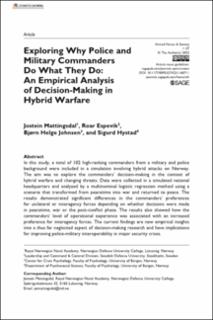| dc.contributor.author | Mattingsdal, Jostein | |
| dc.contributor.author | Espevik, Roar | |
| dc.contributor.author | Johnsen, Bjørn Helge | |
| dc.contributor.author | Hystad, Sigurd William | |
| dc.date.accessioned | 2024-03-21T14:27:04Z | |
| dc.date.available | 2024-03-21T14:27:04Z | |
| dc.date.created | 2023-04-17T13:46:24Z | |
| dc.date.issued | 2023 | |
| dc.identifier.issn | 0095-327X | |
| dc.identifier.uri | https://hdl.handle.net/11250/3123668 | |
| dc.description.abstract | In this study, a total of 102 high-ranking commanders from a military and police background were included in a simulation involving hybrid attacks on Norway. The aim was to explore the commanders’ decision-making in the context of hybrid warfare and changing threats. Data were collected in a simulated national headquarters and analyzed by a multinominal logistic regression method using a scenario that transformed from peacetime into war and returned to peace. The results demonstrated significant differences in the commanders’ preferences for unilateral or interagency forces depending on whether decisions were made in peacetime, war or the post-conflict phase. The results also showed how the commanders’ level of operational experience was associated with an increased preference for interagency forces. The current findings are new empirical insights into a thus far neglected aspect of decision-making research and have implications for improving police-military interoperability in major security crises. | en_US |
| dc.language.iso | eng | en_US |
| dc.publisher | SAGE | en_US |
| dc.rights | Navngivelse-Ikkekommersiell 4.0 Internasjonal | * |
| dc.rights.uri | http://creativecommons.org/licenses/by-nc/4.0/deed.no | * |
| dc.title | Exploring Why Police and Military Commanders Do What They Do: An Empirical Analysis of Decision-Making in Hybrid Warfare | en_US |
| dc.type | Journal article | en_US |
| dc.type | Peer reviewed | en_US |
| dc.description.version | publishedVersion | en_US |
| dc.rights.holder | Copyright 2023 the authors | en_US |
| cristin.ispublished | true | |
| cristin.fulltext | original | |
| cristin.qualitycode | 1 | |
| dc.identifier.doi | 10.1177/0095327X231160711 | |
| dc.identifier.cristin | 2141303 | |
| dc.source.journal | Armed forces and society | en_US |
| dc.identifier.citation | Armed forces and society. 2023. | en_US |

